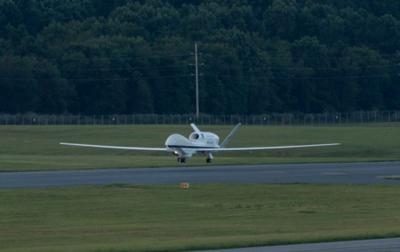Will Fly Above Hurricanes To Improve Track And Intensity Forecasts
NASA’s remotely piloted Global Hawk aircraft will begin flights this week in support of a NOAA-led mission to improve hurricane track and intensity forecasts.

Operating from the aircraft ground control station located at NASA’s Wallops Flight Facility in Wallops Island, Virginia, NOAA will work with NASA scientists on the mission called Sensing Hazards with Operational Unmanned Technology, or SHOUT. The mission builds on earlier collaborative storm research led by NASA and will move the Global Hawk closer to being put into operational use as a weather forecast observations tool.
“We’re flying the Global Hawk above hurricanes and other severe storms to refine it as a new, powerful tool to better forecast where hurricanes go and how intense they are,” said Robbie Hood, director of NOAA’s Unmanned Aircraft System Program. "The mission is part of NOAA’s work to improve our nation’s preparedness and resilience to hurricanes and other severe storms.”
From now until the end of September, pilots and scientists will direct a series of flights out over the Atlantic Ocean basin to collect data on temperature, moisture, wind speed and direction. The real time data will go into National Weather Service forecast models at the National Hurricane Center.
“The Global Hawk allows us to stay over these weather patterns a greater amount of time than manned aircraft,” said Gary Wick, NOAA’s lead scientist for the mission. “It provides us with an observing tool that has the endurance of a satellite but provides finer resolution data and precision of an aircraft.”
The Global Hawk is equipped with instruments to profile the inner workings of storms, including:
- Dropsondes developed by NOAA and the National Center for Atmospheric Research that are released from the aircraft to profile temperature, pressure, wind speed and direction
- High-Altitude Imaging Wind and Rain (HIWRAP) instrument, developed by NASA’s Goddard Space Flight Center and designed to measure precipitation and wind speed
- High Altitude MMIC Sounding Radiometer (HAMSR), a microwave sounder instrument developed by NASA’s Jet Propulsion Laboratory which takes vertical profiles of temperature and humidity
- Lightening Instrument Package (LIP), an instrument managed by NASA’s Marshall Space Flight Center that will measure the electric field of thunderstorms

This season, scientists will also test whether the data from the Global Hawk can help replace data collected by satellites in the unlikely event that a satellite goes down. “We’re hopeful that won’t occur, but we need to evaluate all options,” said Wick.
NASA’s Global Hawk, based at NASA’s Armstrong Flight Research Center in Edwards, California, provides a unique vantage point for weather observations because it flies higher and longer than any manned aircraft. It allows data collection from 60,000 feet, an altitude nearly twice as high as manned aircraft, to the ocean surface. It can gather weather data continuously for up to 24 hours.
SHOUT is funded in part by the Disaster Relief Appropriations Act of 2013, passed by Congress in the wake of Hurricane Sandy.
(Image provided by NASA)
 Sierra Space Repositions Dream Chaser for First Mission
Sierra Space Repositions Dream Chaser for First Mission ANN's Daily Aero-Term (05.10.24): Takeoff Roll
ANN's Daily Aero-Term (05.10.24): Takeoff Roll Aero-News: Quote of the Day (05.10.24)
Aero-News: Quote of the Day (05.10.24) Aero-News: Quote of the Day (05.11.24)
Aero-News: Quote of the Day (05.11.24) ANN's Daily Aero-Term (05.11.24): IDENT Feature
ANN's Daily Aero-Term (05.11.24): IDENT Feature




